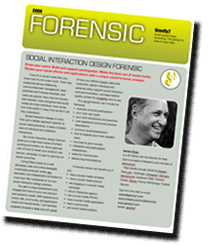While UPS seemed to be tracking conversations as well as we consumers track UPS, conversational marketing and monitoring is still in its infancy. The great difficulty of tuning your tools to the tone of conversation (I like Radian6 and Visible Technologies), the challenge of reading the sentiment and gist from between lines kerned 140 characters wide (Twitter), not to mention spotting influencers and mapping their networks, all suggest that this is a job for specialists. Thankfully, the particular skill involved comes naturally to all of us: it's conversation.
According to Debbie, UPS tracks about four topics over time, with other short-term issues identified as they come up. Her company has established goals and objectives that include an interest in learning from its customers, identifying pain points, and reputation topics, all with the interest of refining corporate and brand messaging. Writ large, they are "using monitoring to learn about the topics that matter to the brand," and are tracking how their brand is being talked about, to "learn how to better provide information to customers."
Several things struck me about UPS. Clearly, the team gets the importance of listening. And in fact Debbie's collaboration with customer service resources was testament to that (all important) insight. UPS, too, is making creative use of internal "driver" blogs, and extending the relationship between its truck drivers and auto-racing drivers (UPS is a NASCAR sponsor, though I suspect their track vehicle of choice is not a van, and operates with its doors closed) with racy first-person narratives. So it has both an internal and public commitment to the medium. It clearly gets the value of watching conversations for customer complaints, and is engaged in ways of addressing and redressing, dare I say re-packaging, customer dissatisfaction.
What I liked the most about the UPS approach was that it emphasized the importance of listening. So much social media marketing still emphasizes the talking. Brands are used to packaging their messages, and deliver them to audiences at great expense. So no, it's not surprising that in social media monitoring they hope to track results. But by viewing the medium as yet another distribution network, they risk missing its greatest strengths.
Which is in part why I still firmly believe that this whole social media marketing thing is still in its infancy. Taking UPS as a springboard for some creative whiteboarding (!), then, here's what I would do if I were the guy with the marker.
Start from the customer's perspective -- it's his/her conversation, after all, and his/her social medium. Advertisers are not as of yet welcome at the table.
Listen to the customer -- what is s/he saying, about what, to whom, and why. Read between the lines, and stick with it. Tools cannot do this, but they can be essential to narrowing down the conversation space, identifying influencers, and mapping the terms and keywords, plus gestures, of the conversation itself.
Join the conversation -- it may be that there is a best person for this within a company, for in fact tone, style, personality and delivery rule here. Conversational talk is not at all like branding, brand messaging, or brand presentation.
Join the conversation, really -- many examples of social media marketing today more closely resemble "adjoining conversations," not joined conversations. That could be a catchphrase, in fact, if it weren't negative: "ad-joining conversational marketing." Be with, not alongside, your customers; let monitoring be a means of eavesdropping that serves the purpose of getting aligned, but don't stay on the sidelines.
Contribute -- social media marketing should be designed around talking, not marketing: talk addressed to people who are talking (new school), not messaging in front of audiences that are looking (old school).
Structure the conversation -- here's where it gets interesting, and where we're going to do some of that whiteboarding. Online conversations are highly unstructured, even informal. The media used tend to flatten out the tonality, sentiment, and delivery of messaging, and outside of social networking sites, the forms of speech users adopt are, well, relatively formless.
What do I mean by this? Well, there are many different kinds of linguistic claims, or statements. Questions, requests, instructions, promises, and so on -- we can recognize them without having to think about it. Social media help users reach audiences of unknown members, and thus users will flatten out statements to appeal to greater numbers of people, while upsetting the fewest number of people. The conversations are generally informal and unstructured: not easily used.
So how about this: design a conversational marketing program around themes, topics, and formats that are natural and familiar, but which you can use and extend. These become brand conversation containers. They will contain messaging points, marketing claims, calls to action (interaction too!), and so on. They can use familiar social media genres, or adapted mass media and cultural forms (invitations, birthdays, top tens, gifts, quizzes, etc).
Let's whiteboard an idea for UPS:
Care packages. The idea here leverages the brand messenger par excellance for UPS: quite literally, the brand driver. The goal is to get conversation going around the brand. The vehicle: use social media to solicit donations to Thanksgiving care packages. Use twitter to solicit Thanksgiving greetings and wishes. Users (customers) donate stuff, or sponsor stuff, to be delivered, with messages, to the elderly at the driver's discretion.
UPS demonstrates that it cares, and gets its customers involved by packaging *their* care. (Why not have customers vote on care package designs contributed by the public, and composed of the tweeted messages. Maybe even localize the messaging...) The brand shows that it cares that its customers care, and wants to be the vehicle of appreciation and concern. Drivers post gratitudes to a company blog. Comments are collected. Branding and service become a mutual win-win.
Gas Think Tank. This is totally off the top of my head, so here goes tapping the thinking cap for a gas tank meter. UPS gets transparent with its customers about the high cost of gas, and the company's role in climate change, by sharing gross gas expenditures and carbon output on a blog, let's call it "the UPS think tank." There, it solicits ideas and contributions from customers about how to reduce its carbon "tire mark," offering to fund investment in ways to green the brown van. These might include sponsored online causes, use of twitter hashtags, perhaps even sponsorship of a commuter or car-sharing site where UPS drivers offer to carshare to work if customers do the same.
Conversational marketing can be much more interesting than just watching the brief and fleeting messages posted to social media that directly reference your brand. We're really just at the tip of the iceberg. The brands that show success will be those that can shift from talking about themselves to talking to their customers. I honestly believe that if brands structure their efforts to create conversational brand extensions, there will be a flourishing of new and compelling creativity in social media campaigns. These can be cost-effective, engaging, and learning moments.
During times like these, we should all consider how to step up, save money, and do some good.
More from UPS Monitoring social media for big business: Guest Blogger - Debbie Curtis-Magley, UPS
More tips on social media and PR
Labels: blogging, pr, social analytics, social media marketing




